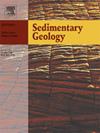The importance of sedimentary structures in fine-grained deposits in re-interpreting the Facies mosaic of Lower Triassic tide-influenced deltas
IF 2.9
2区 地球科学
Q1 GEOLOGY
引用次数: 0
Abstract
Despite considerable progress in their description and characterization, tide-dominated deltas remain the least understood of the three main delta classes. Fine-grained sediments of the deltaic subenvironments remain particularly understudied, especially via ultra-thin section analysis. Such analysis can aid in identifying subenvironments typically missed in paleodelta analysis (e.g., delta plains). Combined with other methods, they can prove valuable in evaluating depositional and sequence-stratigraphic models and exploring the interplay between sediment supply and channel morphologies.
This study focuses on the Lower Triassic Torrey Member of the Moenkopi Formation of southern Utah. Previous interpretations posit that the Torrey Member represents a tide-dominated delta deposited in three depositional sequences. Integrating mudstone thin section analysis helped reveal that the Torrey Member contains ten facies associations, with the facies architecture indicating deposition by tide-dominated or tide-influenced deltas over a single depositional sequence. The progradational phase is notable for its decreased channel density and concurrent increase in subaerial exposure indicators. This study posits that hyperycnal flows, including bedload transport, dominated deposition in the prodelta and delta front of the Torrey Member, with no direct evidence of tidal processes.
This study broadly demonstrates the importance of integrating mudstone thin-section analysis in paleodelta studies. This paper particularly draws particular attention to delta plain identification in semi-arid and arid settings and suggests that thin-section analysis may reveal examples previously missed in similar paleodeltas.
细粒沉积构造在重新解释下三叠统潮染三角洲相镶嵌中的重要性
尽管在描述和表征方面取得了相当大的进展,但潮控三角洲仍然是三种主要三角洲类型中最不为人所知的。对三角洲亚环境的细粒沉积物的研究尤其不足,特别是通过超薄切片分析。这样的分析有助于识别古三角洲分析中通常遗漏的亚环境(例如三角洲平原)。与其他方法相结合,它们在评价沉积和层序地层模型以及探索沉积物供应与河道形态之间的相互作用方面具有重要价值。本研究以犹他州南部Moenkopi组下三叠统Torrey段为研究对象。以前的解释认为,托里段代表了一个潮汐控制的三角洲,沉积在三个沉积序列中。综合泥岩薄片分析揭示了托里段包含10个相组合,其相构型表明在单一沉积层序上沉积了潮汐控制或潮汐影响的三角洲。在渐积期,沟道密度下降,同时地面暴露指标增加。本研究认为,托里段前三角洲和三角洲前缘的沉积主要是高旋流,包括床质搬运,但没有潮汐作用的直接证据。该研究广泛地证明了泥岩薄片综合分析在古三角洲研究中的重要性。本文特别关注半干旱和干旱环境下的三角洲平原识别,并建议薄切片分析可能揭示以前在类似的古三角洲中遗漏的例子。
本文章由计算机程序翻译,如有差异,请以英文原文为准。
求助全文
约1分钟内获得全文
求助全文
来源期刊

Sedimentary Geology
地学-地质学
CiteScore
5.10
自引率
7.10%
发文量
133
审稿时长
32 days
期刊介绍:
Sedimentary Geology is a journal that rapidly publishes high quality, original research and review papers that cover all aspects of sediments and sedimentary rocks at all spatial and temporal scales. Submitted papers must make a significant contribution to the field of study and must place the research in a broad context, so that it is of interest to the diverse, international readership of the journal. Papers that are largely descriptive in nature, of limited scope or local geographical significance, or based on limited data will not be considered for publication.
 求助内容:
求助内容: 应助结果提醒方式:
应助结果提醒方式:


